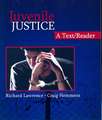Organization and Management in the Criminal Justice System: A Text/Reader: SAGE Text/Reader Series in Criminology and Criminal Justice
Autor Matthew J. Giblinen Limba Engleză Paperback – 11 noi 2013
From organizational theory to managing a criminal justice organization, this book is a must-read for anyone pursuing a career in criminal justice administration.
Preț: 560.41 lei
Preț vechi: 1105.55 lei
-49% Nou
Puncte Express: 841
Preț estimativ în valută:
107.24€ • 111.33$ • 89.43£
107.24€ • 111.33$ • 89.43£
Carte indisponibilă temporar
Doresc să fiu notificat când acest titlu va fi disponibil:
Se trimite...
Preluare comenzi: 021 569.72.76
Specificații
ISBN-13: 9781452219929
ISBN-10: 1452219923
Pagini: 672
Dimensiuni: 187 x 232 x 24 mm
Greutate: 0.97 kg
Ediția:1
Editura: SAGE Publications
Colecția Sage Publications, Inc
Seria SAGE Text/Reader Series in Criminology and Criminal Justice
Locul publicării:Thousand Oaks, United States
ISBN-10: 1452219923
Pagini: 672
Dimensiuni: 187 x 232 x 24 mm
Greutate: 0.97 kg
Ediția:1
Editura: SAGE Publications
Colecția Sage Publications, Inc
Seria SAGE Text/Reader Series in Criminology and Criminal Justice
Locul publicării:Thousand Oaks, United States
Cuprins
Section I. Introduction: Why Should We Study Criminal Justice Organizations?
Section II. Organizational Structure: How Do We Build Organizations?
Reading 1. The Impact of Centralization and Formalization on Correctional Staff Job Satisfaction and Organizational Commitment by Eric G. Lambert, Eugene A. Paoline, and Nancy Lynne Hogan
Reading 2. Factors to Consider for Optimal Span of Control in Community Supervision Evidence-Based Practice Environments by Gaylene S. Armstrong
Reading 3. The Organizational Structure of International Drug Smuggling by Jana S. Benson and Scott H. Decker
Section III. Organizational Theory: How Do We Explain What Organizations Look Like?
Reading 4. “McJustice”: On the McDonaldization of Criminal Justice by Robert Bohm
Reading 5. Maintaining the Myth of Individualized Justice: Probation Presentence Reports by John Rosecrance
Section IV. Organizational Deviance and Termination: What Explains Failure in Criminal Justice Agencies?
Reading 6. Bureaucracy, Managerial Disorganization, and Administrative Breakdown in Criminal Justice Agencies byClarissa Freitas Dias and Michael S. Vaughn
Reading 7. Social Theory and the Street Cop: The Case of Deadly Force by Klinger, David
Section V. Interagency Collaboration: Are Two or More Organizations [Combined] Better Than One?
Reading 8. The Intelligence Fusion Process for State, Local, and Tribal Law Enforcement by David L. Carter and Jeremy G. Carter
Reading 9. A Specialized Domestic Violence Court in South Carolina: An Example of Procedural Justice for Victims and Defendants by Angela R. Gover, Eve M. Brank, and John M. MacDonald
Section VI. Unions and Collective Bargaining: United We Stand?
Reading 10. Police Employee Organizations by Colleen Kadleck
Reading 11. Prison Officer Unions and the Perpetuation of the Penal Status Quo by Joshua Page
Section VII. Organizational Socialization: How Does a Person Learn to “Behave” in an Organization?
Reading 12. Saying One Thing, Meaning Another: The Role of Parables in Police Training by Robert E. Ford
Reading 13. An Officer and a Lady: Organizational Barriers to Women Working as Correctional Officers in Men’s Prisons by Nancy C. Jurik
Section VIII. Motivation and Job Design: How Do We Light a Fire Under Employees?
Reading 14.Motivation as a Predictor of Therapeutic Engagement in Mandated Residential Substance Abuse Treatment by Matthew L. Hiller, Kevin Knight, Carl Leukefeld, and D. Dwayne Simpson
Reading 15.Organizational Justice and Police Misconduct by Scott E. Wolfe and Alex R. Piquero
Reading 16.Job Design, Community Policing, and Higher Education: A Tale of Two Cities by Charles W. Sherwood
Section IX. Occupational Stress and Burnout: Is This Job Killing Me?
Reading 17. A Qualitative Assessment of Stress Perceptions Among Members of a Homicide Unit by Dean A. Dabney, Heith Copes, Richard Tewksbury, and Shila R. Hawk-Tourtelot
Reading 18. The Nature of Occupational Stress Among Public Defenders by David R. Lynch
Reading 19. Factors Contributing to Levels of Burnout Among Sex Offender Treatment Providers by Rebecca A. Shelby, Rebecca M. Stoddart, and Kathryn L. Taylor
Section X. Leadership: Are You a Leader or a Follower?
Reading 20. The Ineffective Police Leader: Acts of Commission and Omission by Joseph A. Schafer
Reading 21. Leadership and Correctional Reform by James B. Jacobs and Elana Olitsky
Section XI. Power in Organizations: How are Subordinates, Suspects, Inmates, and Clients Controlled?
Reading 22.The Society of Captives: A Study of a Maximum Security Prison by Gresham M. Sykes
Reading 23.The Limits of Individual Control? Perceived Officer Power and Probationer Compliance by Hayden P. Smith, Brandon K. Applegate, Alicia H. Sitren, and Nicollette Fariello Springer.
Reading 24. Gender, Power, and Reciprocity in the Correctional Setting by Denise L. Jenne and Robert C. Kersting
Section XII. Organizational Change: What Causes Organizations to Transform?
Reading 25.Lessons from the Battle over D.A.R.E.: The Complicated Relationship Between Research and Practice byGreg Berman and Aubrey Fox
Reading 26. Improving Criminal Justice Through Better Decision Making: Lessons From the Medical System by Daniel P. Mears and Sarah Bacon
Glossary
References
Credits and Sources
Index
About the Author
Section II. Organizational Structure: How Do We Build Organizations?
Reading 1. The Impact of Centralization and Formalization on Correctional Staff Job Satisfaction and Organizational Commitment by Eric G. Lambert, Eugene A. Paoline, and Nancy Lynne Hogan
Reading 2. Factors to Consider for Optimal Span of Control in Community Supervision Evidence-Based Practice Environments by Gaylene S. Armstrong
Reading 3. The Organizational Structure of International Drug Smuggling by Jana S. Benson and Scott H. Decker
Section III. Organizational Theory: How Do We Explain What Organizations Look Like?
Reading 4. “McJustice”: On the McDonaldization of Criminal Justice by Robert Bohm
Reading 5. Maintaining the Myth of Individualized Justice: Probation Presentence Reports by John Rosecrance
Section IV. Organizational Deviance and Termination: What Explains Failure in Criminal Justice Agencies?
Reading 6. Bureaucracy, Managerial Disorganization, and Administrative Breakdown in Criminal Justice Agencies byClarissa Freitas Dias and Michael S. Vaughn
Reading 7. Social Theory and the Street Cop: The Case of Deadly Force by Klinger, David
Section V. Interagency Collaboration: Are Two or More Organizations [Combined] Better Than One?
Reading 8. The Intelligence Fusion Process for State, Local, and Tribal Law Enforcement by David L. Carter and Jeremy G. Carter
Reading 9. A Specialized Domestic Violence Court in South Carolina: An Example of Procedural Justice for Victims and Defendants by Angela R. Gover, Eve M. Brank, and John M. MacDonald
Section VI. Unions and Collective Bargaining: United We Stand?
Reading 10. Police Employee Organizations by Colleen Kadleck
Reading 11. Prison Officer Unions and the Perpetuation of the Penal Status Quo by Joshua Page
Section VII. Organizational Socialization: How Does a Person Learn to “Behave” in an Organization?
Reading 12. Saying One Thing, Meaning Another: The Role of Parables in Police Training by Robert E. Ford
Reading 13. An Officer and a Lady: Organizational Barriers to Women Working as Correctional Officers in Men’s Prisons by Nancy C. Jurik
Section VIII. Motivation and Job Design: How Do We Light a Fire Under Employees?
Reading 14.Motivation as a Predictor of Therapeutic Engagement in Mandated Residential Substance Abuse Treatment by Matthew L. Hiller, Kevin Knight, Carl Leukefeld, and D. Dwayne Simpson
Reading 15.Organizational Justice and Police Misconduct by Scott E. Wolfe and Alex R. Piquero
Reading 16.Job Design, Community Policing, and Higher Education: A Tale of Two Cities by Charles W. Sherwood
Section IX. Occupational Stress and Burnout: Is This Job Killing Me?
Reading 17. A Qualitative Assessment of Stress Perceptions Among Members of a Homicide Unit by Dean A. Dabney, Heith Copes, Richard Tewksbury, and Shila R. Hawk-Tourtelot
Reading 18. The Nature of Occupational Stress Among Public Defenders by David R. Lynch
Reading 19. Factors Contributing to Levels of Burnout Among Sex Offender Treatment Providers by Rebecca A. Shelby, Rebecca M. Stoddart, and Kathryn L. Taylor
Section X. Leadership: Are You a Leader or a Follower?
Reading 20. The Ineffective Police Leader: Acts of Commission and Omission by Joseph A. Schafer
Reading 21. Leadership and Correctional Reform by James B. Jacobs and Elana Olitsky
Section XI. Power in Organizations: How are Subordinates, Suspects, Inmates, and Clients Controlled?
Reading 22.The Society of Captives: A Study of a Maximum Security Prison by Gresham M. Sykes
Reading 23.The Limits of Individual Control? Perceived Officer Power and Probationer Compliance by Hayden P. Smith, Brandon K. Applegate, Alicia H. Sitren, and Nicollette Fariello Springer.
Reading 24. Gender, Power, and Reciprocity in the Correctional Setting by Denise L. Jenne and Robert C. Kersting
Section XII. Organizational Change: What Causes Organizations to Transform?
Reading 25.Lessons from the Battle over D.A.R.E.: The Complicated Relationship Between Research and Practice byGreg Berman and Aubrey Fox
Reading 26. Improving Criminal Justice Through Better Decision Making: Lessons From the Medical System by Daniel P. Mears and Sarah Bacon
Glossary
References
Credits and Sources
Index
About the Author
Descriere
This text/reader exposes students to original primary works (26 readings) in the field of organization and management while providing them with a comprehensive review of the field.








